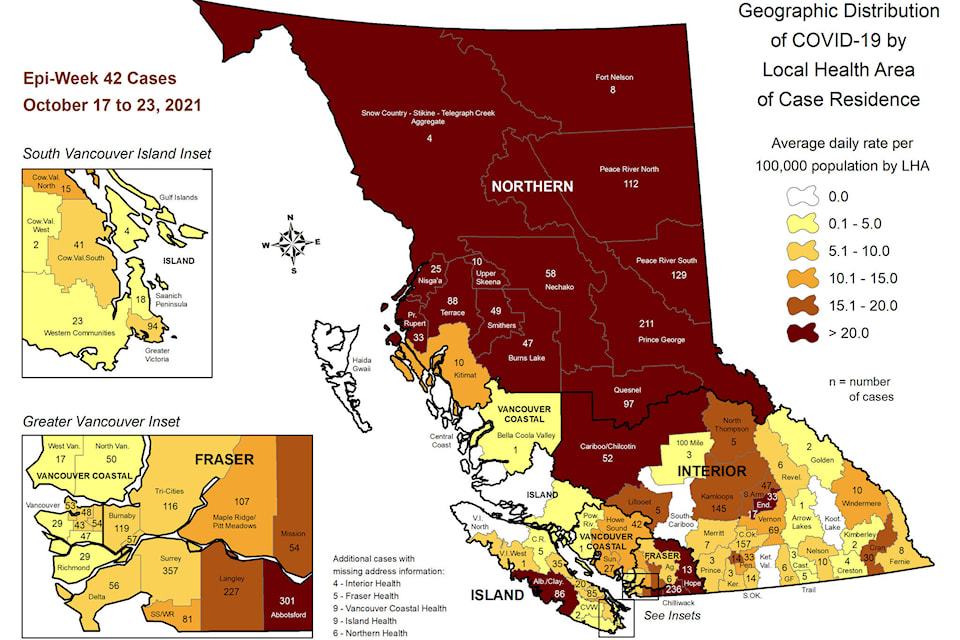New COVID-19 cases in the Smithers Local Health Area (LHA) continued to decline during the latest reporting period.
The LHA (Houston to Witset) saw 49 new cases between Oct. 17 and 23 down from 58 the previous week.
This still represents a high daily rate of 38 cases per 100,000 population as the Northern Health Region continues to be the main area of concern for provincial health authorities.
The vaccination rate for Smithers remained comparatively low with 70 per cent of eligible residents having received two doses compared to the provincial average of 84.7 per cent.
Meanwhile, Terrace recorded the most new COVID-19 cases between Oct. 17 to 23 than any other LHA in northwest B.C. for the second week in a row.
The Terrace LHA saw 88 new cases, up from 71 reported during the previous week (Oct. 10 to Oct. 16). Kitimat reported a decrease from 16 to 10 new cases and Prince Rupert’s number of new cases rose from 13 to 33, according to the latest British Columbia Centre for Disease Control (BCCDC) data.
Every LHA in the Northern Health Authority reported an average daily case rate of greater than 20 per 100,000 people except for Kitimat and Haida Gwaii at 13 and zero cases per 100,000 people, respectively.
There were zero new cases on Haida Gwaii and 25 in the Nisga’a LHA. There were four new cases in the combined Snow Country - Stikine - Telegraph Creek LHAs.
The BCCDC figures for cases in the Nass Valley may differ from the Nisga’a Valley Health Authority’s (NVHA) statistics because of differences in the way those organizations report cases.
In response to a recommendation by the NVHA, the Nigsa’a Lisims government endorsed a pause on cultural gatherings for three weeks, starting Oct. 29 to Nov. 19 as the daily case rate in the LHA rose to 215 per 100,000 population.
There were 10 new cases in the Upper Skeena LHA.
Further east, there were 47 new cases in Burns Lake, 58 in Nechako and 211 in Prince George.
Northern Health is currently monitoring COVID-19 outbreaks at two northwest hospitals.
In Smithers, four inpatients tested positive and one of those patients died in connection to a COVID-19 outbreak at the Bulkley Valley District Hospital. As of Oct. 19, the outbreak declaration does not include the maternity section of the inpatient unit.
One death is associated with an outbreak at Wrinch Memorial Hospital (WMH) in Hazelton. Eight patients and two staff members had tested positive for the virus as of Oct. 15.
Both hospitals are under enhanced outbreak control measures and monitoring.
According to the BCCDC, Kitimat has hit 88 per cent of eligible people fully vaccinated against COVID-19 — the only LHA in Northern Health higher than the province-wide average of 84.7 per cent on Oct. 28.
Two-dose vaccination coverage by Northwest LHA, (per cent change from the previous week is indicated by brackets):
Kitimat - 88 per cent (+1)
Haida Gwaii - 83 per cent (+1)
Nisga’a - 82 per cent (+2)
Prince Rupert - 81 per cent (+2)
Snow Country - Stikine - Telegraph Creek - 79 per cent (+1)
Terrace - 77 per cent (+1)
Upper Skeena - 75 per cent (+2)
Smithers - 70 per cent (+1)
B.C. Centre for Disease Control data shows that unvaccinated individuals are much more likely to become hospitalized and die as a result of COVID-19.
The age-adjusted data, which covers approximately the last four weeks, shows that unvaccinated individuals are nine times more likely to become a case (Sept. 21 to Oct. 18), 43 times more likely to become hospitalized and 36 times more likely to die (Sept. 18 to Oct. 15).
As of Oct. 28, COVID-19 case numbers are stabilizing on a provincial level, but Adrian Dix, health minister, said that the Northern region had a test positivity rate of 19 per cent on Wednesday compared with a rate of four to five per cent for the rest of the province.
B.C.’s health ministry is beginning to offer third doses of COVID-19 vaccine, starting with seniors, Indigenous people and other high-risk groups and moving to the general population in an age-based system starting in January.
Third doses have already begun for seniors in long-term care and will continue with older people in the community, starting with people aged 70 and older by December. Public health data are showing “breakthrough” infections increase with age among people who have received two doses. Indigenous communities and higher-risk people are to be offered third shots for all age groups.
Registration will be required for second and third doses as the vaccination effort moves away from drop-in clinics, except for those who are receiving first doses. Pharmacies will be participating in the third dose program, which will use messenger RNA vaccines produced by Pfizer and Moderna, including for those who received AstraZeneca vaccine for their initial immunization.
Northern Health is booking appointments and offering drop-in clinics for first and second doses.
A drop-in clinic at the Dze L K’ant Friendship Centre for first and second shots is open today (Oct. 28) until 3:45 p.m.
There will also be clinics Nov. 17-18 and Nov. 23-25 at Dze L K’ant from 9 a.m. to 12 p.m. and 1 p.m. to 3:45 p.m.
On the following dates people will also be able to get a flu shot at Dze L K’ant: Nov. 2, 4, 9, 12-13 and 16.
For more information or to book an appointment, visit the Northern Health website or call 1-833-838-2323.
— With files from Tom Fletcher, Katya Slepian, the Canadian Press and Thom Barker
